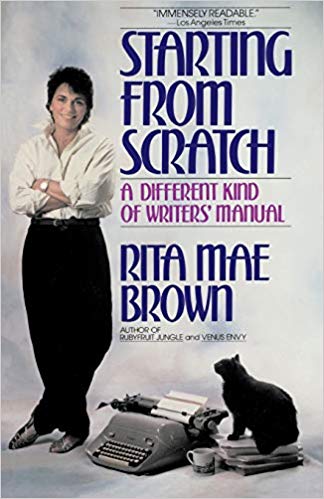A Writer’s Mechanic’s Manual for Any Car on the Road
Okay, first thing and before anything else, Get This Book!
I don’t care where you are in your writing career, Rita Mae Brown’s Starting from Scratch will give you a chuckle (several hundred, probably) and clarify things that were not only muddy, but had been pushed aside because they were just too damn hard to figure out.
Worry no more, Rita’s got you covered.
I didn’t know who Rita Mae Brown was until a friend suggested I give her a read. This was back in the early-mid 1980s. He thought she was brilliant and hilarious.
That didn’t tempt me.
Then he told me she could benchpress 225#.
Yes, I was that much of an assh?le (may still be) that that caught my interest.
But I didn’t pick up one of her books (that I remember) until my first go-round as a writer. That book being Starting from Scratch.
Reading the book recently, it’s obvious I had read it at least once before; there were highlights in it. There were highlights of concepts I remember, if not exact phrasings. Truth be told, I was probably unprepared for the book when I first read it (my copy was published in Feb 1988). I’m glad I kept it around.
Starting from Scratch is a mechanic’s manual of the English language. Brown explains the purpose of first v third person POV with duh! level examples and lots of them. Ditto subjunctive case (trust me, you need to read this section). Ditto strong v weak verbs (another must read). Imagine someone showing you a crescent wrench and a 9/16″ box-end, showing you they can do the same thing, then demonstrating why one works better on these types of nuts, the other works better on those types of nuts.
Her Exercises chapter…remember what I wrote above about being impressed by her bench? Here’s your cardio and resistance training in one incredible package.
Greetings! I’m your friendly, neighborhood Threshold Guardian. This is a protected post. Protected posts in the My Work, Marketing, and StoryCrafting categories require a subscription (starting at 1$US/month) to access. Protected posts outside those categories require a General (free) membership.
Members and Subscribers can LogIn. Non members can join. Non-protected posts (there are several) are available to everyone.
Want to learn more about why I use a subscription model? Read More ch-ch-ch-ch-Changes Enjoy!
 “On the face of it, you wouldn’t think there was any connection between the murder of a dead man and the events that changed my perceptions about my life.” – Sue Grafton’s “J” is for Judgment
“On the face of it, you wouldn’t think there was any connection between the murder of a dead man and the events that changed my perceptions about my life.” – Sue Grafton’s “J” is for Judgment

